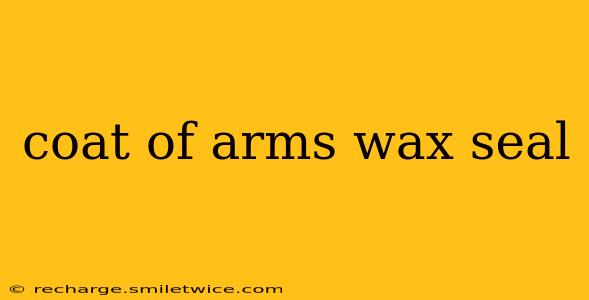Coat of arms wax seals add a touch of timeless elegance and historical significance to correspondence, documents, and invitations. They evoke a sense of tradition and authority, transforming a simple act of sealing into a statement of personal identity or brand heritage. This detailed guide explores the fascinating world of coat of arms wax seals, covering everything from their historical context to the process of creating your own.
What is a Coat of Arms Wax Seal?
A coat of arms wax seal uses a molten wax impression to reproduce a family crest, personal emblem, or corporate logo. This creates a visually striking and secure closure for letters, invitations, or other important documents. The intricate detail achievable with a wax seal makes it a far more sophisticated alternative to a simple sticker or stamp. The weight and feel of the wax itself contribute to the overall luxurious and prestigious effect.
How are Coat of Arms Wax Seals Made?
The process of creating a coat of arms wax seal involves several key steps:
-
Design: Begin by choosing or designing your coat of arms. This could be a family crest, a personal emblem you’ve created, or a company logo. High-resolution digital images are ideal for achieving a crisp impression.
-
Seal Creation: The design is then used to create a metal seal. This can be done through various methods, including laser engraving or a more traditional approach involving a skilled craftsman. The quality of the seal significantly impacts the clarity of the wax impression.
-
Wax Selection: Choose your wax. Different waxes offer varying colors, textures, and scents. Beeswax is a popular choice for its natural beauty and subtle honey scent. Other options include resin-based waxes, which offer a harder, more durable seal.
-
Sealing Process: Melt the wax using a wax seal warmer or a candle. Carefully pour the melted wax onto the desired surface. Quickly press the seal into the wax before it cools, ensuring firm and even pressure for a crisp impression.
-
Cooling and Finishing: Allow the wax to cool completely before handling. Once cooled, the seal can be further embellished with ribbons, cords, or other decorative elements.
What are the Different Types of Wax Seals?
While the basic process remains consistent, several variables influence the final product:
-
Wax Type: As mentioned earlier, beeswax offers a natural, slightly malleable seal, while resin waxes provide a harder, more durable finish. Colored waxes further enhance the aesthetic appeal.
-
Seal Material: Metal seals (usually brass or pewter) are the most common, but wooden or even custom-made seals are also possible.
-
Seal Design: This is where personalization shines. Whether it's a traditional coat of arms, a modern monogram, or a unique design representing your personal brand, the possibilities are limitless.
What is the History of Coat of Arms Wax Seals?
The use of wax seals to authenticate documents and demonstrate authority dates back centuries. In medieval times, coat of arms wax seals were primarily used by royalty and nobility to verify the authenticity of official documents and letters. The unique design of the seal served as a form of personal identification and a mark of prestige. Over time, the practice spread to other classes, becoming a symbol of status and trustworthiness. Even today, wax seals add a touch of old-world charm and authenticity.
Where Can I Buy a Coat of Arms Wax Seal?
Numerous online retailers and craft stores sell wax seals, wax, and related supplies. You can also commission a custom-made seal from artisans specializing in crafting personalized seals. Be sure to check reviews and compare pricing before making your purchase.
Can I Make My Own Coat of Arms?
Yes, while traditional coats of arms have specific heraldic rules and regulations governing their design and use, you can create a personalized emblem that represents your family, business, or personal brand. Many online resources offer guidance on creating unique designs. However, remember that legally using an existing coat of arms without permission is usually not allowed.
How Much Does a Coat of Arms Wax Seal Cost?
The cost of a coat of arms wax seal varies depending on several factors: the complexity of the design, the type of metal used for the seal, whether it's a custom-made design, and the cost of the wax itself. Expect to pay anywhere from a few dollars for a simple, pre-made seal to hundreds of dollars for a custom-designed and crafted piece.
In conclusion, coat of arms wax seals offer a unique blend of history, artistry, and practicality. They add a touch of elegance and sophistication to any occasion while serving as a meaningful symbol of personal identity or brand heritage. The process of creating and using a wax seal is both rewarding and surprisingly easy to master.
